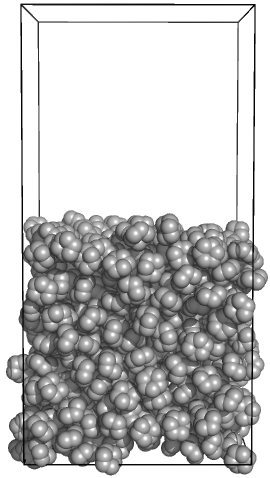GROMACS Tutorial
Step Two: Add Water to Construct
|
Placing two layers of solvent relative to one another is a simple matter of using the editconf module. We will define a unit cell of desired dimensions and place the cyclohexane layer at a specific location within it. Once satisfied with the placement, we can fill the rest of the box with water. Following the equilibration of my 466-molecule cyclohexane layer, the box dimensions were 4.30795 nm in each dimension. The goal of this exercise will be to build the biphasic system such that it has a water layer of equivalent size. Thus, we will keep the x- and y-dimensions fixed, and double the system size in z. The trick here is that if we define such a box for our cyclohexane system, editconf will automatically center the cyclohexane layer in it. While not incorrect (since, because of periodicity, the proper interfaces will still form), such a position is not advantageous if we want to add, for example, a small protein or peptide into the water layer. A divided layer will not easily allow us to do this. Fortunately, editconf allows us to manually specify a center for our system. Since we want to keep the cyclohexane layer essentially in the same place while we just increase the box, we will specify a system center at (x/2, y/2, z/4), which is normal centering within the original box (x/2, y/2, z/2), since GROMACS builds all boxes from the coordinate origin. gmx editconf -f chx_10ns.gro -o chx_newbox.gro -box 4.30795 4.30795 8.6159 -center 2.153975 2.153975 2.153975 We now have a system aligned in the following way: 
Now, the only remaining task is to solvate the empty space with water. This is easily done with solvate: gmx solvate -cp chx_newbox.gro -cs spc216.gro -p chx.top -o chx_solv.gro The solvate module will place some water molecules within the cyclohexane layer, so make a copy of the file
|

Site design and content copyright Justin Lemkul
Problems with the site? Send them to the Webmaster